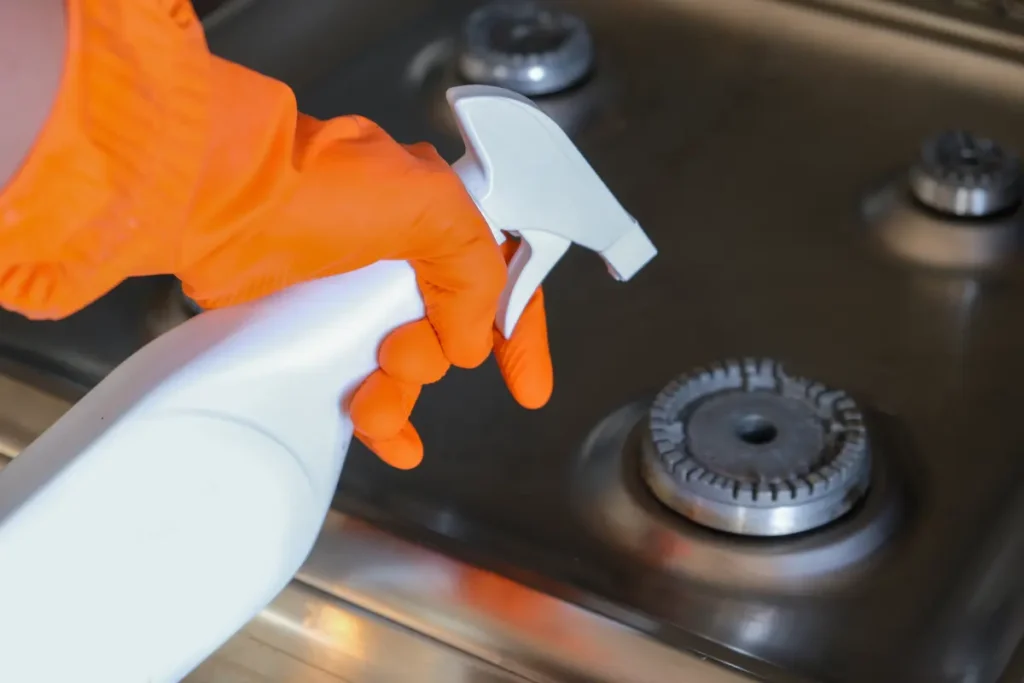In today’s bustling world, where culinary creations are crafted with passion and flair, our kitchens serve as the heart of our homes.
However, amidst the sizzle and aroma, an inevitable foe often emerges – stubborn grease. Grease buildup not only tarnishes the beauty of your kitchen but can also pose health hazards and fire risks.
Understanding the Culprit: Grease 101
Before we dive into the magical world of effective grease cleaning, let’s understand our enemy.
Grease, typically originating from cooking oils, butter, and food residue, is a sticky substance that adheres to various surfaces in the kitchen.
Over time, it accumulates, becoming a challenging adversary to eradicate.
The Power of Natural Cleaners
1. Lemon Infusion Miracle
Lemon, nature’s gift to cleaning enthusiasts, possesses incredible grease-cutting properties. Mix lemon juice with vinegar to create a potent natural cleaner.
The acidity of lemon dissolves grease, leaving your surfaces sparkling clean and fresh.
2. Mighty Vinegar
Vinegar, the unsung hero in your kitchen, is a versatile cleaner. Its acidic nature not only cuts through grease but also disinfects surfaces.
Combine vinegar with baking soda for a dynamic duo that annihilates stubborn grease, leaving no trace behind.
Essential Tools: Your Arsenal Against Grease
To effectively combat grease, you need the right tools in your cleaning arsenal:
1. Microfiber Magic
Microfiber cloths are not only eco-friendly but also exceptional at trapping grease particles. Their fine fibers grip onto grease, allowing you to wipe surfaces effortlessly.
Ditch disposable wipes and embrace the reusable wonders of microfiber cloths.
2. Steam Cleaners: Grease’s Greatest Nemesis
Investing in a steam cleaner can revolutionize your battle against grease. High-temperature steam not only dissolves grease but also sanitizes surfaces.
It’s an eco-friendly option that leaves no chemical residues behind, ensuring a safe and grease-free environment.
Pro Tips for Specific Surfaces
1. Gleaming Stainless Steel
Stainless steel appliances elevate the aesthetics of your kitchen but are magnets for fingerprints and grease. Use a mixture of mild dish soap and warm water to clean stainless steel surfaces gently. Buff with a microfiber cloth for a streak-free shine.
2. Tackling Greasy Grout
Grout, often overlooked, is a notorious hiding spot for grease. Create a paste using baking soda and water. Apply it to grout lines, let it sit for a few minutes, and then scrub with an old toothbrush. Witness the transformation as the grease disappears, revealing clean and bright grout lines.
Prevention: The Ultimate Solution
While effective cleaning methods are essential, preventing grease buildup is key to a perpetually clean kitchen. Adopt these habits to maintain a grease-free haven:
1. Regular Maintenance
Consistent cleaning routines prevent grease from accumulating. Wipe down surfaces after each cooking session and deep clean at least once a week.
Regular maintenance not only keeps grease at bay but also preserves the longevity of your kitchen appliances.
2. Ventilation Is Vital
Proper ventilation, such as using exhaust fans or opening windows, reduces the accumulation of airborne grease particles.
Adequate ventilation ensures that grease doesn’t settle on surfaces, making your cleaning efforts more manageable.
In conclusion, armed with natural cleaners, essential tools, and preventive habits, you can bid farewell to stubborn grease and revel in the joy of a spotless kitchen.
Embrace these tips, and your kitchen will radiate cleanliness and freshness, creating a welcoming environment for culinary adventures.








